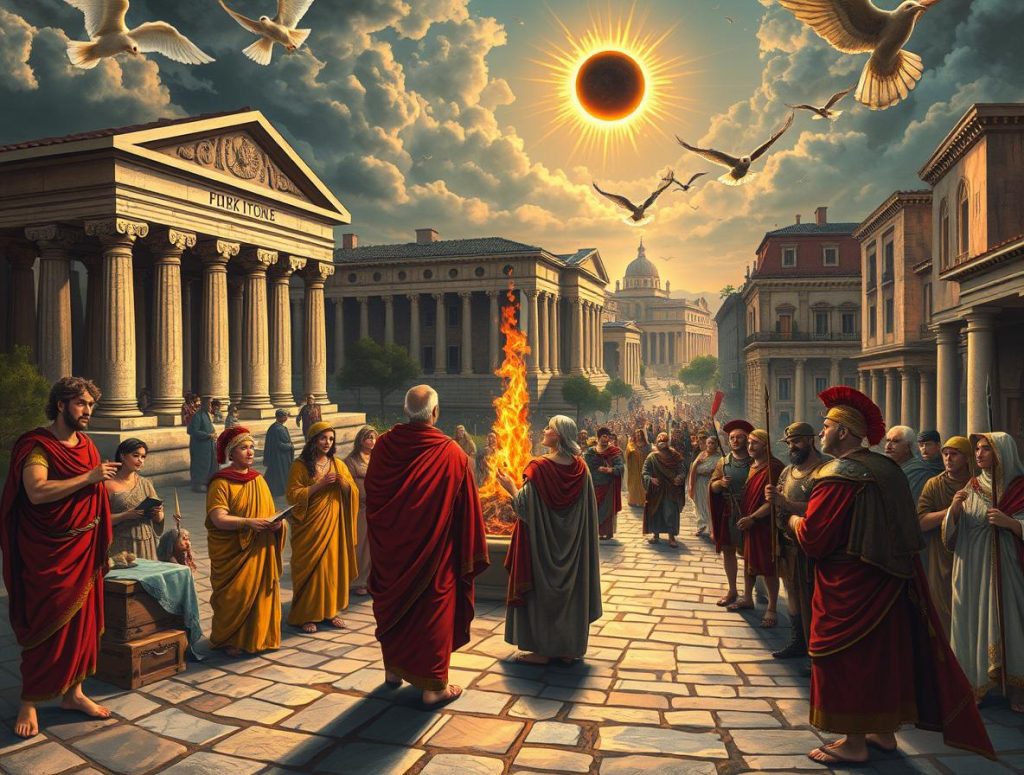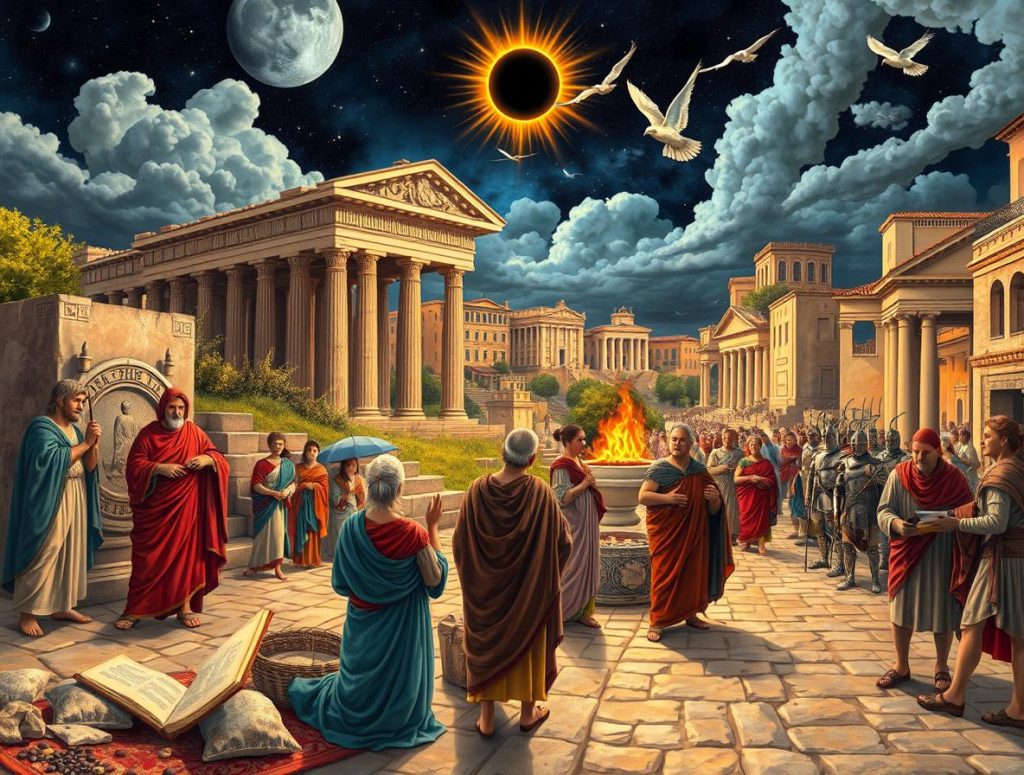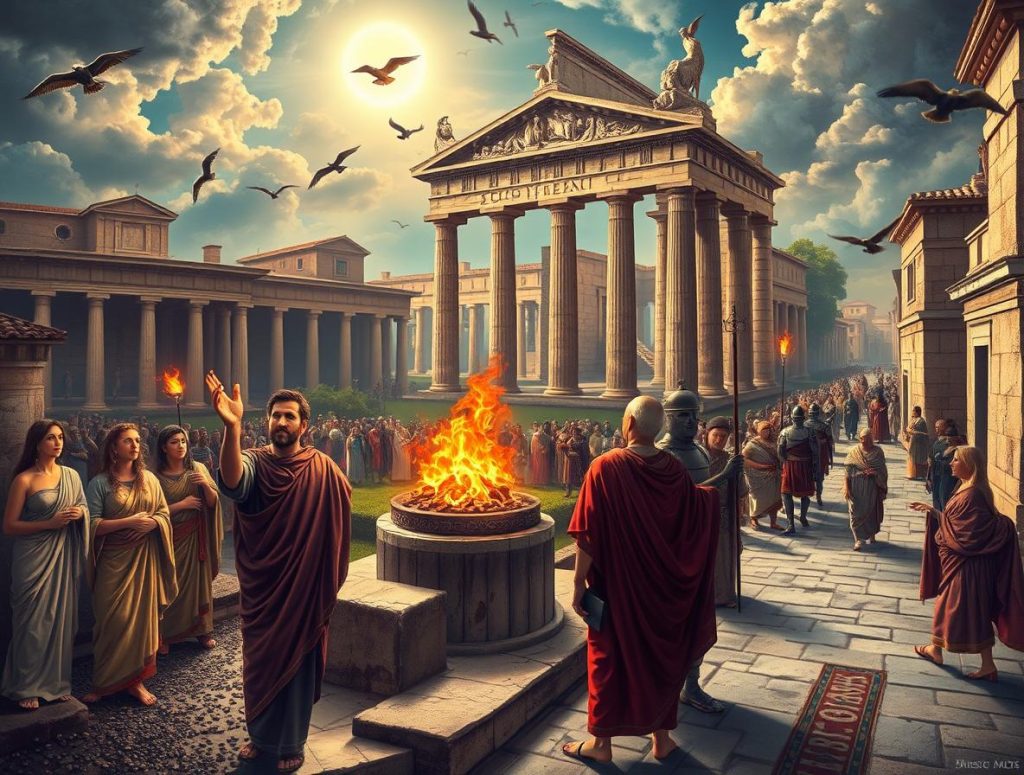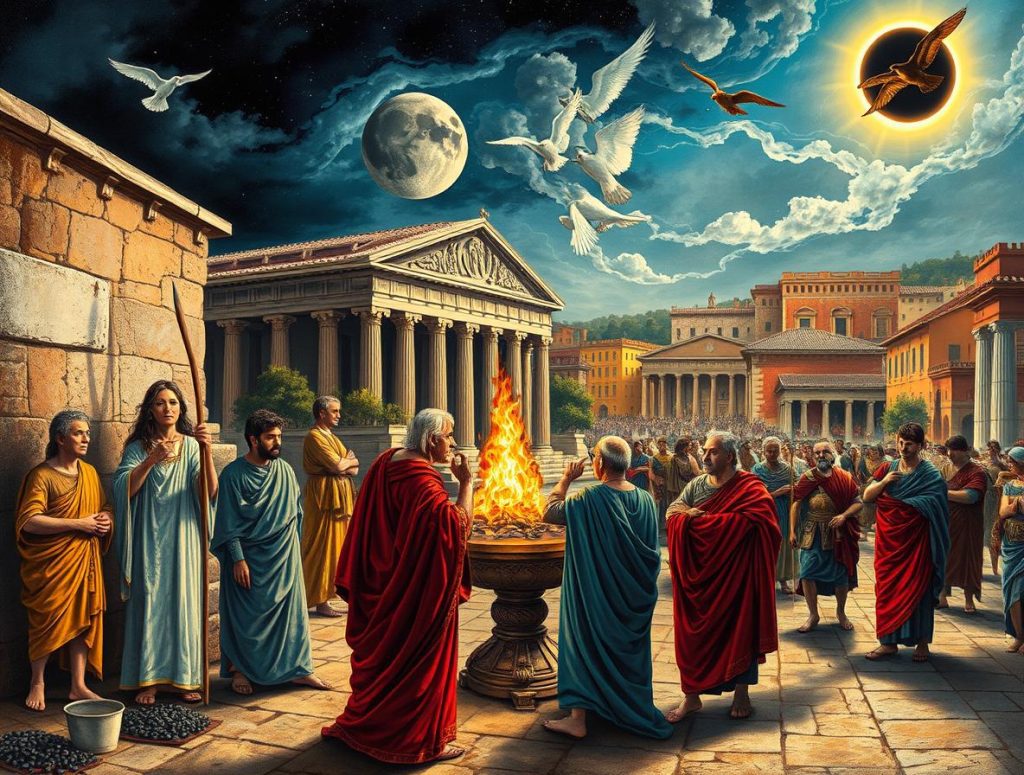The history of ancient Rome is a fascinating subject that encompasses various aspects, from its governance to daily life, religion, and the rise and fall of its empire.
Governance: The Transition from Monarchy to Republic
The structure of power during the Roman Republic, which lasted from 509 to 27 BCE, marked a significant transition in governance. It moved from a monarchy to a complex political structure that laid the foundation for modern democracies.
Daily Life: The Impact of Social Class
Daily life in ancient Rome was vastly different for the various social classes. The social class divide was pronounced, especially between the patricians and plebeians. Their daily activities, traditions, and ways of living were starkly different.
Religion: A Comprehensive System
Religion also played a crucial role in ancient Rome. It was not merely a set of beliefs but a comprehensive system that intertwined with every aspect of their lives. This is evident in our exploration of ancient Roman religion, where we see how religion influenced politics, culture, and social structures.
Empire: The Rise and Fall
The rise and fall of the Roman Empire is another significant aspect of its history. Spanning over a millennium, this ancient civilization has left an indelible mark on the world, shaping politics, culture, and society in ways that continue to resonate today.
Gender Dynamics: The Legal Status of Women
Lastly, it’s important to note the legal status of Roman women, which reflects a complex interplay of rights and restrictions that significantly influenced gender dynamics in ancient Rome. Their citizenship was intrinsically linked to their relationships with men, such as fathers or husbands.

The Foundations of Roman Superstition
Roman religion was deeply intertwined with the belief in a vast pantheon of gods and countless spirits influencing every aspect of life. These divine beings were not distant deities but active forces whose favor or wrath could shape individual destinies and the fate of the entire state. The Romans saw their world as animated by supernatural forces that required constant attention and respect.
Omens and divine signs played a pivotal role in Roman spirituality. Natural phenomena, unusual animal behavior, or unexpected events were interpreted as messages from the gods. The practice of augury, reading bird flights, and haruspicy, inspecting animal entrails, were formalized methods used by priests to decipher these signs. Romans trusted these interpretations to guide critical decisions—from military campaigns to political actions.
Interpreting omens was a cultural necessity rather than mere superstition. Ignoring a bad sign could invite disaster, while recognizing a favorable one promised success and prosperity. This constant vigilance shaped social norms and governance, embedding superstition into the fabric of daily Roman life. Understanding these spiritual foundations helps explain why seemingly bizarre rituals permeated everything from personal habits to state ceremonies.
The patricians, the wealthy and powerful elite of ancient Rome, were different from the working-class plebeians. They were usually rich landowners who had significant influence and control over the resources and politics of their time.
Beans and the Souls of the Dead
Beans held a unique place in Roman superstition, especially regarding the dead. The Lemuria festival, celebrated in May, was dedicated to appeasing restless spirits believed to haunt the living. During this ritual, Romans would throw black beans behind them at midnight while chanting spells to drive away malevolent ghosts lurking near their homes.
Beans as Symbols of Souls
This practice ties into broader ancient symbolism where beans represented the souls of the deceased—a tangible connection between the living and the spirit world. The act of casting beans was more than superstition; it was a protective measure rooted in fear of spiritual contamination or harm.
The Role of Left Side Superstition
The left side superstition also played a role here, as things associated with death or bad omens were often linked to the left, considered evil, while the right symbolized good luck and positive forces. Beans, connected to spirits and death, were part of this complex system of beliefs that shaped daily Roman behavior and rituals.
The Influence of Roman Roads
Interestingly, these rituals and superstitions were facilitated by the extensive network of Roman roads, which served as vital arteries for trade and cultural exchange throughout the empire. Today, beans and similar objects still appear in symbolic contexts—whether in folklore or cultural practices—highlighting how these bizarre superstitions of Ancient Rome continue to echo through time.
The Roman Empire, known for its vast territories and rich culture, was also a center of remarkable advancements. From the incredible engineering feats that changed the world to the complex social dynamics reflected in the lives of gladiators, the legacy of Rome continues to fascinate and influence modern society.

Superstitions Affecting Social Customs and Events
Ancient Romans held strong beliefs that shaped social customs, especially surrounding weddings and home life. Certain months were considered more auspicious for marriage, with May notoriously avoided due to its association with ill omens and the restless spirits of the dead. This made it an unlucky time to begin a union. Instead, June, the month dedicated to Juno, protector of marriage and childbirth, became the preferred and sacred month for weddings. This preference has trickled down through centuries, influencing contemporary wedding traditions where June remains popular for nuptials.
These wedding customs are just a part of the broader influence of Roman law, which has played a crucial role in shaping modern legal systems. The principles of this ancient law are still relevant in various legal systems today.
Doorways had special significance in Roman superstition as thresholds between the living world and the realm of spirits. People believed that spirits could pass through these portals, so rituals developed to protect households:
- Touching doorposts upon entering or leaving
- Offering prayers or blessings to household gods called Lares
- Hanging protective charms or symbols near entrances
These practices aimed to keep evil forces out while inviting good fortune in. Many cultures today still observe customs involving doorways—like knocking on wood or crossing fingers—that echo these ancient protective rituals.
Whistling indoors was another taboo rooted in fear of attracting malevolent spirits. Romans thought whistling summoned evil entities into the home, disrupting peace and safety. This superstition parallels modern sayings warning against whistling inside houses or theaters, reflecting a lingering cultural caution against actions believed to disturb spiritual harmony.
Interestingly, similar superstitions can be found in other cultures as well. For instance, Ukrainian superstitions often involve practices related to weddings and home life, much like those in Ancient Rome. On the other hand, Russian superstitions also reflect a deep-seated belief system that influences social customs and events.
The bizarre superstitions of Ancient Rome still echo in modern times, shaping both social events like weddings and everyday behaviors around our homes. Understanding these customs also provides insight into the enduring influence of Roman mythology on modern culture, as well as the significant achievement that is the Corpus Juris Civilis, which not only preserved ancient Roman legal principles but also adapted them to the needs of contemporary society.
The exploration of ancient Rome offers a fascinating glimpse into a world shaped by various factors, including military might and social dynamics.
The Role of the Roman Army
The Roman Army, a symbol of military power, played a crucial role in the growth and upkeep of the Roman Empire. Its structure, strategies, and operational effectiveness were key in achieving victories across large areas.
Understanding Plebeian Life
In contrast to the military elite, there existed a substantial population known as plebeians, who were the common people of ancient Rome. These individuals comprised a diverse group of free citizens not part of the patrician elite. Understanding plebeian life is essential for grasping the social dynamics of Rome, as they represented the majority and significantly influenced the development of political and economic structures.
Modern Interpretations through Virtual Platforms
Additionally, the modern interpretation of Roman life can be explored through immersive experiences in platforms like Second Life. For example, JP Farmer, an academic with a passion for role-playing games, enjoys bringing history to life in such virtual environments. He particularly immerses himself in the world of Romanum within Second Life, where he explores and interacts with the rich history of Rome in an engaging manner.

Religious Figures, Natural Phenomena, and the Legacy of Roman Superstitions Today
The Vestal Virgins in Ancient Rome held an essential role tied to religious purity and the city’s welfare. These priestesses were charged with maintaining the sacred fire of Vesta, symbolizing Rome’s eternal life. Their strict purity vows were not merely personal commitments but civic duties believed to sustain the divine favor upon the city. Breaking these vows was seen as a dire threat to Rome’s stability, resulting in severe punishments such as burial alive — a grim reminder of the spiritual gravity attached to their role. The reverence for such religious purity echoes today in various cultural and religious rituals where sanctity and moral conduct are still highly valued.
Natural Omens and Their Influence
Romans read natural omens as divine signs expressing the gods’ will or warnings about future events. Famines, eclipses, storms, and even deformed animals were interpreted as messages from the divine realm. For example:
- An eclipse might signal impending disaster or displeasure from the gods.
- Deformed livestock could be seen as ill omens for harvests or war.
- Unusual weather patterns often prompted public rituals to appease supernatural forces.
These interpretations influenced political decisions and public morale. Some interpretations of natural phenomena have persisted into modern times within certain Christian contexts where miracles or unusual natural events are seen as signs of divine intervention.
The Impact on Numerology
Roman superstition also deeply affected numerology. The avoidance of particular numbers—especially even numbers—originated from beliefs that certain digits carried bad luck or disrupted cosmic harmony. This tradition lives on in modern superstitions surrounding “unlucky numbers,” such as 13 in Western cultures or 4 in East Asian contexts with Roman roots influencing early European numerology.
Protective Talismans: Then and Now
The legacy extends into protective talismans used today. Ancient Romans often wore amulets or placed charms in homes to ward off evil spirits or attract good fortune. Phallic charms representing fertility and protection are an example already discussed, but beyond that:
- Modern jewelry shaped like ancient symbols continues to serve as protective talismans.
- Some contemporary cultural practices involving lucky charms trace directly back to Roman-origin beliefs.
- Protective symbols embedded in architecture reflect this ancient concern for spiritual safety around entrances and thresholds.
This blend of religious authority, natural omens, and symbolic protection forms a core part of how Roman superstitions have influenced both historical and contemporary views on fate, luck, and spirituality.
The Spectacle of Ancient Rome
Additionally, the spectacle of Ancient Rome, characterized by gladiators, chariot races, and theaters played a crucial role in society, influencing social relationships and political authority. This aspect is just one part of the broader legacy of Ancient Rome, which remains a cornerstone of Western civilization today.
Understanding these connections reveals much about the origins of many modern superstitions still observed today and how ancient laws like the Twelve Tables have shaped our legal systems.

Conclusion
The lasting impact of Roman superstitions reveals itself in unexpected ways throughout modern culture. Many beliefs once deemed bizarre continue to shape customs, language, and social behaviors today. From avoiding certain numbers to the cautious interpretations of omens, these ancient practices form a subtle but persistent thread in our cultural heritage.
Understanding the historical roots behind these superstitions allows you to appreciate their role beyond mere superstition. They reflect deep human desires for control, protection, and meaning in an uncertain world. Recognizing this helps you see how traditions evolve yet remain connected across millennia.
Key takeaways from the Bizarre Superstitions of Ancient Rome Still Echoing in Modern Times include:
- The endurance of ancient beliefs influencing present-day rituals
- The way superstition intertwines with religion, society, and personal behavior
- Insights into how cultural habits carry historical significance
Exploring these connections enriches your perspective on why certain customs endure — not as relics, but as vibrant parts of living culture.
FAQs (Frequently Asked Questions)
What role did superstitions play in the daily life of Ancient Romans?
Superstitions were deeply embedded in daily Roman life, influencing decisions and behaviors through beliefs in omens, divine signs, and supernatural forces. Romans interpreted these signs to guide their fate and maintain favor with the gods.
Why were owls considered bad omens in Ancient Rome, and how does this belief persist today?
In Ancient Rome, owls were feared as harbingers of doom and associated with death and misfortune. This cultural fear has parallels in modern superstitions where owls are often linked to bad luck or ominous events.
How did Ancient Romans view the left and right sides differently in terms of luck?
Romans believed the left side was evil while the right side brought good luck. This belief influenced various behaviors, such as interpreting sneezes from the right as fortunate and those from the left as unlucky, a superstition that echoes in some modern sayings.
What were some common Roman superstitions related to weddings and social customs?
Romans avoided May for marriages due to superstitions but favored June because of the goddess Juno’s protection. They also practiced rituals involving doorways, like touching doorposts for protection, and considered whistling indoors taboo to avoid inviting evil spirits—customs that have influenced contemporary traditions.
How did superstition influence Roman military practices?
Roman generals preferred odd-numbered troop formations believing they brought better fortune. Protective phallic charms were used for fertility and safety, while divination methods like augury and haruspicy guided military decisions. These practices highlight the integration of superstition into military strategy.
What is the legacy of Roman superstitions in modern culture?
Many modern superstitions trace back to Roman beliefs, including avoiding certain unlucky numbers, use of protective talismans inspired by ancient amulets, and interpretations of natural phenomena as divine signs. Understanding these roots helps appreciate cultural habits that persist today.

